#da analysis
Text
I know many people immediately hate Varania for betraying Fenris, but I think in her eyes, it was the best she could do for him.
When Fenris kills Hadriana, he says that Danarius must know that Fenris knows about his sister. Could there even be a world in which Danarius is monitoring Varania constantly? Checking through all the messages she got, having her followed, reading the messages she sends to Fenris, using his influence as a magister to make sure Varania’s work was never quite successful- keeping her desperate for a way to have a decent quality of life. Like if she straight up said no to his proposition he could literally just have her blacklisted from whatever line of work she wanted to be in, so she’d be forced to come back to him, groveling. “””Best””” case scenario is Varania gets to Kirkwall, hangs out with Fenris for a few days, Danarius captures Varania and tells Fenris that if he doesn’t come back, he’s gonna torture Varania. With this in mind, Varania’s best play is to go along with Danarius from the get go. And the sad part is, that’s also the best for Fenris in Varania’s mind. If Fenris returns to slavery with his sister as his masters apprentice, she would be in a position of authority- one she could use to help him, ease his struggles. And think about the way Varania reacts to seeing her brother again. She isn’t cackling maniacally and twirling her stick-on curly mustache- she sounds devastated he actually showed up. This, to me, doesn’t read like she was power seeking. It feels like she genuinely cared for her brother despite the resentment she felt toward him due to her struggles of being a free elf in a slave society.
Now, do I believe that Danarius would hold up his end of the bargain? Absolutely not. I think he’d plot to have to disposed of the second the three of them landed on Seheron to replace her with a respectable (read:human) apprentice. At that point, it’d be far harder to Fenris to escape.
I truly don’t believe Varania ever had a real moment of agency in the situation. She, like many of those whose misfortune lands them in Kirkwall, is a tragic character. I hope she was able to find work in the Free Marshes.
#Varania#Fenris#da2#da analysis#dragon age#my post#if she’s not featured in future content I will die#Danarius
169 notes
·
View notes
Text

house on house violence
#love the disconnect between my analysis posts and literally just saying shit#in da house#house md#gregory house#greg house#s7#season 7#moving on
580 notes
·
View notes
Text
Take My Hand again actually we're gonna go on a walk through Night Raven College campus real quick while I lose my mind

First off look at the front gate. People have definitely brought up the birds and the keys and those ARE both very important symbols, BUT. What about the thorns sprawled across the top of the gate? And the repeat use of 4-pointed stars in the lettering gives an especially prickly quality, overall.

Also of note are the decorations on the main pillars and the very specific aesthetic choice for the shape of the wrought-iron fence—by which I mean both reflect designs found in Draconimom's appearance.
The carvings on the gate pillars feature an ankh-like shape that matches up eerily well with the central decor of Draconimom's belt, as well as two curves that mimic the main body of the belt. The three-leaf/bud-like shape above that is reflected in the lace pattern and dangling decoration of the Mirror Chamber's chandelier. The two swooping S-shapes mimic the Draconia family's iconic horns, and the little decorations on either side of the carving match with the shape of Draconimom's pauldrons.

As for the fence…it's That Shape again. Each post also bears resemblance to the upper portion of Draconimom's staff.

Considering the focus on thorned vines in relation to Diasomnia/the Draconias, the way that vines are slowly creeping up both the fenceposts and gate pillars feels relevant.
(Please recall: The coffins by which students are summoned into NRC are also referred to as "Gates.")

Next stop is the botanical garden. As I mentioned in a previous post, the building's overall shape is notably similar to the chandelier found in the Mirror Chamber. The large beams surrounding the building, with their spear-like support pillars, give the impression of the building being held in place by thorned vines.


The inside of the garden doesn't yield much in the way of analysis, unfortunately. The most stand-out feature is the crumbling structure in the subtropical zone, but that arguably could've been intentionally allowed to decay as a way of cultivating the various mosses and lichens we see growing on it.
(Please recall: at the beginning of the game, before you choose a student, Crowley has a monologue in which he appears to refer to the Dark Mirror as "a lovely and noble flower of evil.")
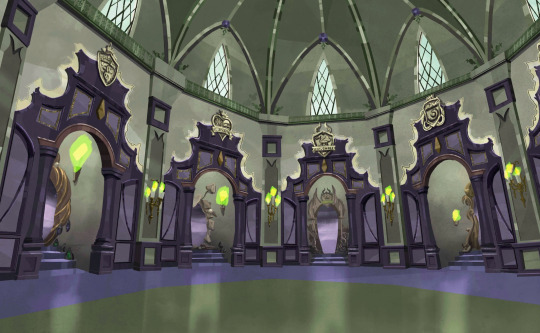
And now the Hall of Mirrors. This one has subtler details than the others, but still just enough for the pattern recognition part of my brain to start making noises.
Again, the outside of the hall bears a passing resemblance to the chandelier in the Mirror Chamber, though much less so than the botanical garden. More important to this analysis is the inside of the building.
Listen. Not all lace is related to overblots. But the majority of lace in Twisted Wonderland HAS appeared in relation to overblots. The presence of an unmistakably lace-y pattern on the beams under each ceiling arch feels worth pointing out. After all, as of Book 7, at least one student per dorm linked to the Hall of Mirrors has overblotted.

There are also small floral decorations on each arch: two buds in the lower corners, and a bloom at the top. Again, Crowley's "flower of evil" comment comes into play; each dorm, again, features a major antagonist who is visually and textually placed parallel to their respective member of the Great Seven (OG Disney villains).

There's also. Y'know. The horn-like design on the pillars.

(Please recall: each dorm linked to the Hall of Mirrors is, apparently, contained within a pocket dimension with somewhat strict borders.)

Okay now we're at the coliseum and I need you to bear with me for this first point. Look at the entrance. It's too ostentatious to not be important somehow, right? It's too overdone. It's the Dark Mirror's mask, kinda? Don't ask how long I've been staring at this thing
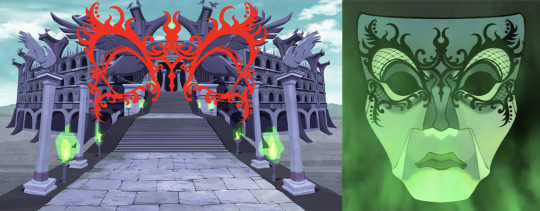
Aside from that, the coliseum has thorns lining the rim of the structure twofold. One set of thorns exists as spears jutting out along the rim, while the other set exists as the long, simple, repeating pattern on the wall just under those spikes. On the outside of the building, this pattern repeats for every floor, effectively giving a sense that the structure is "wrapped" in thorns.

There are also thorns visible in the support beams of the stage; they're especially noticeable after Malleus fixes the stage, as they're lit up a bright pink (as opposed to the gold they were prior).

Upon the stage sits an odd, crumbling structure. It's clearly made of a different type of stone than the rest of the coliseum, being a dark gray instead of subdued purple, but that's not all—the architecture doesn't match up, either. The two main columns don't resemble any others found in the coliseum, notably. The arch-and-a-half visible both distinctly feature three-pointed arches, unlike the round arches consistently found throughout the rest of the building.
The fact this structure has been allowed to remain in such a deteriorated state is also worth questioning, especially since it's obviously been modified at some point fairly recently; the LCD screen it's been fitted with seems to work like a normal electronic device w/ no magical component to it. Even if you were to argue that the structure is supposed to have a distinct aesthetic from the rest of the coliseum to better draw attention to the stage it rests on, its condition renders the argument null. I love its decrepit vibe as much as Malleus might, but very few people would see this as an acceptable "centerpiece" for such an important location. With how Crowley squawks about maintaining the school's reputation, why does this pass by without comment from him…?
At least the chains frame the stage nicely. Though, they could serve a symbolic purpose as well…
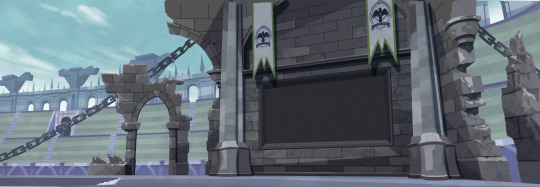
(Please recall: according to Rook, the school staff claims that the coliseum is "imbued with a special field that makes it harder for damage to spill out." We can assume that this is the truth, as no one outside of the coliseum seemed to notice Vil's overblot—just the traces of excessive magical energy leftover afterwards.)

And finally, we come to the Mirror Chamber. Keeping in mind that the Dark Mirror can teleport people (both for enrollment and in general), the most notable visual qualities of this room are as follows:
Gates (coffins, the Dark Mirror)
Plants (chandelier, rose arches, standing lamps, windowpanes)
Mirrors (the Dark Mirror)
Containment (chains, coffins, the Dark Mirror)
It is very, very interesting that the four primary structures on NRC campus with a direct relationship to the items on this list also feature aesthetic similarities to the Mirror Chamber. Also of note is that although each structure chiefly embodies one item on the list, they all incorporate aspects of the other items:
Front Gate–
Plants: As previously noted, there are vines steadily attempting to overtake the fence and pillars + thorns sprawling across the top of the sign.
Mirrors: Structural design is mirrored across the vertical axis, carvings are mirrored across both horizontal and vertical axes.
Containment: Although open in this view, the front gate as a whole embodies the concept of NRC campus as an area that is closed off to the rest of the world.
Botanical Garden–
Gates: The entire building signifies a departure from the surrounding campus into a space especially designed for the housing and growing of plants.
Mirrors: Look at that thing. You can't have a building made mostly out of tempered glass and not have it be reflective as fuck.
Containment: Aside from the appearance of being held down by thorned vines, the building does, again, exist for the purpose of containing plants.
Hall of Mirrors–
Gates: Each mirror acts as gate leading to each of the seven dorms.
Plants: Previously-detailed floral decorations.
Containment: Again, each mirror contains a dorm. This, in turn, means that this building technically contains…nearly the entire student body.
Coliseum–
Gates: It's got one right out front lmao. But yeah, like the botanical garden, the building signifies a departure from the surrounding environment.
Plants: As mentioned earlier, the entire building has the appearance of being wreathed in thorned vines + further incorporation of thorns in the stage.
Mirrors: Previously-shown Dark Mirror comparison. Also, like the front gate, the structural design is mirrored across the vertical axis.
What does this all mean? NO fuckin clue. But if we consider how the very first battle of the game seems to take place in the Mirror Chamber, at least two of these locations have been (or will be) the setting for a major overblot battle.
(I will say…it's very funny that, despite Pomefiore being the first established dorm from a lore perspective, a lot of the campus has much more Diasomnia-esque aesthetics.)
#twst#twisted wonderland#twst meta#meleanor draconia#night raven college#design analysis#twisted rambling#nearly 1.5k words and i'm tired of looking at this thing. change da world. my final message. goodb ye
175 notes
·
View notes
Text
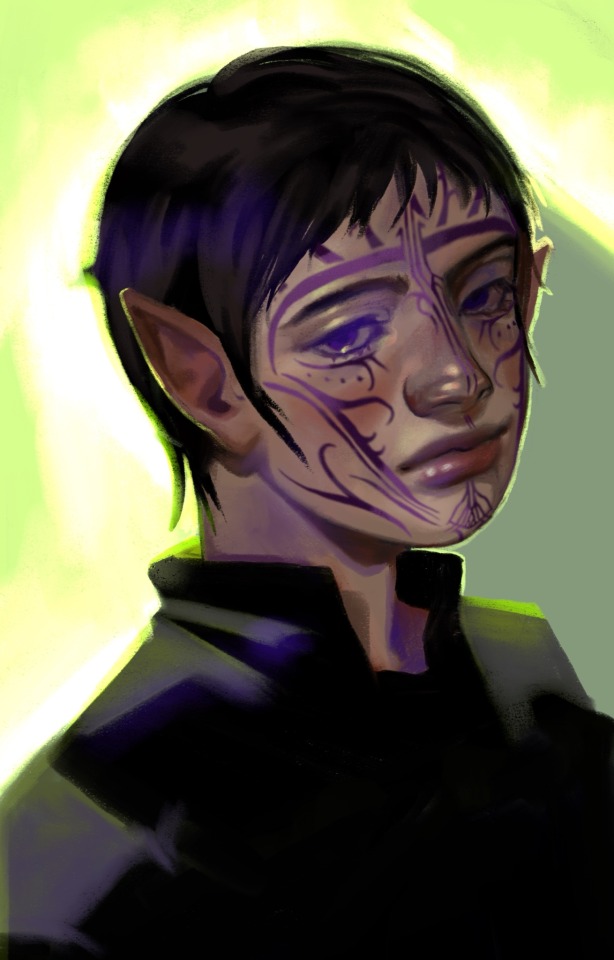




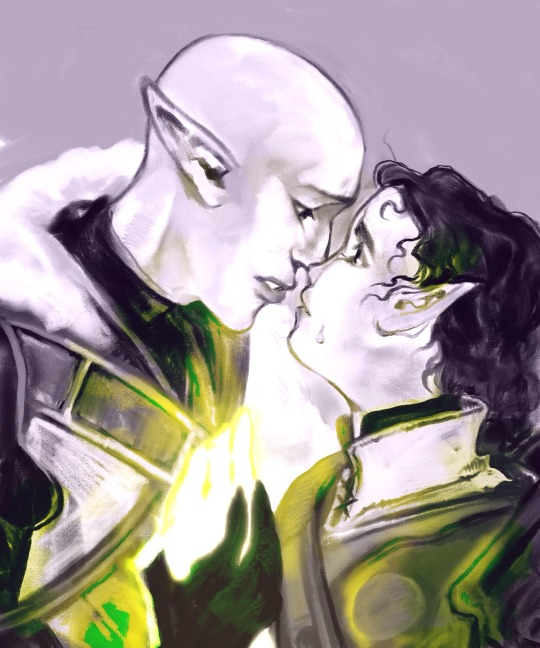
My Inquisitor ocs Dahlas and Ethvir
#dragon age#dragon age inquisition#da:i#da: inquisition#dragon age oc#lavellan#solas dragon age#sera dragon age#sera#solas#solavellan#inquisitor#inquisitor oc#they are siblings lol#I have much to say about them and a lot written but it’s all incomprehensible and CRINGE#Ethvir is the canon inky#there’s like three alt universes in which they exist to me#I also have an analysis and reasoning regarding their names lol#forgive me if my elvhen is off rip#my art#my ocs
47 notes
·
View notes
Text
One of the scenes im very excited to be animated is the introduction of the golden kingdom and Yaad. Specifically the scene where they cook and eat with him,

its a sweet scene but also showcases the horror of the situation the people of the golden kingdom are in very well. Theyve been alive so long they can no longer enjoy food because of their dulled senses. They can no longer enjoy living at all.
One of dungeon meshis most important messages is to eat properly and have a healthy relationships with food. How life, death, and food, are heavily intertwined. That eating is the privilege of the living.
And the people of the golden kingdom have lived so long that eating means nothing to them.
They are unable to have that relationship with food at all. Theyve lived so long they can no longer enjoy the taste of food. Nor do they have that appetite, for food and for life, anymore.
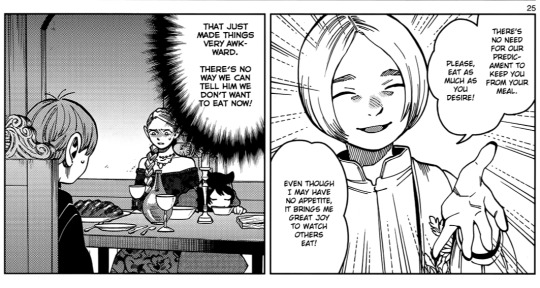
Its why their meal at the end of the series hits so hard for me. Theyre finally free of the curse of an eternal life and they can now finally enjoy the privileges of food, of life, and of death. The privilege of seeing the sun in the sky every morning and watching the moon set at night. The privilege of eating a sick ass drag-
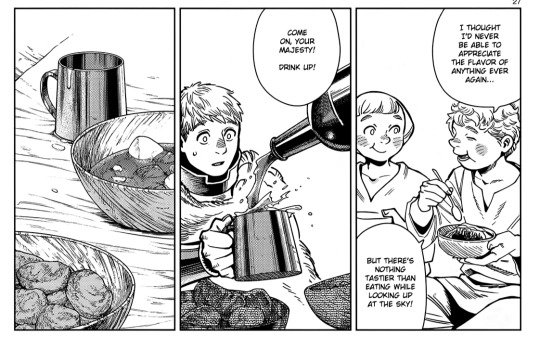
TLDR; im obsessesed with everything to do with the golden kingdom and i will explode when its animated
#dungeon meshi#dungeon meshi spoilers#yaad dungeon meshi#i could go on and on about the golden kingdom yall dont even know#this isnt a very structed analysis just me yapping tbh. id love to write a full analysis on the golden kingdom ....a project for another da
45 notes
·
View notes
Text
Dazai is drawn to honest characters.
Dazai is drawn to ppl who have a high moral code.
Dazai is drawn to ppl who feel so much so easily.
Dazai is drawn to ppl who are nothing like him...
#Oda Chuuya Atsushi#that is what I mean by honest#Add Sigma for the feel sm so easily#Kunikida for the high moral code#I'm not sure where Ango fits into this#smn help me with that#yeah that's just a pattern I've picked up#as for Fyodor? i don't feel Dazai's drawn to him as it's more of a 'oh we think on the same wavelength'#to the point where he'd deem it boring#man certainly looked a bit bored in some scenes in Meursault#even more so in DA dvdhjske#had the driest convos known to man#lmao#bsd#dazai osamu#bungou stray dogs#bsd dazai#bungo stray dogs#analysis(?)#bsd analysis#J's post
35 notes
·
View notes
Text
A closer examination of Fenris and Anders' party banter
There's two particular Anders-Fenris party banter that gets pointed out a lot as them being antagonistic to each other, but upon second readings, they both can seem like genuine attempts at connection:
Fenris: Is there something you want, Anders?
Anders: You really don't have the temperament for a slave.
Fenris: Is that a compliment or an insult?
Anders: I'm just wondering how your master didn't kill you.
Fenris: How have the templars not killed you?
Anders: I'm charming.
Here, it almost seems like Anders is saying, "You rebelled against your oppressors too, huh? I had to survive by being charming. I just wonder how you did it." It was a moment of acknowledgement and recognition, that Fenris, too, rebelled against the ones who had power over him and survived, just like Anders did.
Fenris: You should have lived in Tevinter. You'd be happier there.
Anders: You're probably right.
Fenris: There, your magic would be a mark of honor. Apprenticed to the right Magister, you would do well.
Anders: Is there a down side?
Fenris: Only if you're bothered by owning a few slaves and performing the occasional blood ritual.
Anders: So they all do those things?
Fenris: Just the ones who don't complain about how powerless and persecuted they are.
And in this banter, it's almost as if Fenris is saying, "No, you aren't like the mages and magisters I met in Tevinter. You're different." All the 'normal' practices of Tevinter like blood rituals and owning slaves ... Fenris knows that Anders would never do that. I'm tempted to even say it was almost a compliment -- Fenris acknowledges Anders' talents as a mage, but also recognizes that Anders has no desire to social-climb, and that is what differentiates Anders from the power-hungry magisters of Tevinter.
Their banter looks like vicious sniping on the surface, but on closer inspection, they really were just a hair's breadth away from making a connection.
This banter from the 'Legacy' DLC drives me insane because it was literally right there. We were so close to a breakthrough.
Anders: When I left the Wardens, I swore I'd never spend another minute in the Deep Roads.
Fenris: "Left" sounds like it was a mutual arrangement.
Anders: Fine. I ran away. What's it to you?
Fenris: Ran away from the Circle, ran away from the Wardens... it sounds like a habit.
(If Hawke is in a romance with Fenris)
Anders: Running away from your family, straight to Danarius. Running away from Danarius, straight to Hawke. Maybe we're more alike than you think.
(Otherwise)
Anders: And you ran away from Danarius. Maybe we're more alike than you think.
(if Varric is in the party)
Varric: I've always said so.
If only BioWare's writing had allowed them to explore that common ground and be allies, even friends. They understand each other on a level the other companions couldn't. They recognize themselves in each other, they could have supported one another because both of them know exactly what it means to be constantly on the run, looking for escape, looking for a place to belong to. Not to mention it would have been such a compelling development to their relationship!
But no, for the sake of forced grey morality, where both sides needed to be portrayed as equally good and bad, BioWare needed to use Anders and Fenris as mouthpieces for opposing sides so they couldn't allow the relationship to ever evolve past arguing with each other, despite seven years of companionship and proximity.
#the analyses of these party banter are courtesy of lesetoilesfous and potatowitch on the Fenders Discord Server#i just wanted to document it somewhere#too many people are quick to dismiss anders and fenris' relationship as just hating each other and just leave it at that#their relationship had so much potential to be so much more#but bioware never wanted to explore that potential#fenders#bioware critical#character analysis#da meta#da2 meta#dragon age 2#fenris dragon age#anders dragon age#fenris da2#anders da2#fenders meta
297 notes
·
View notes
Text
i dont think im done talking abt this, actually. i'm going to try and explain how stupid this whole thing is because there's always SOMEONE going on about how if it wasn't for the circles, and the parallels of the circles to real-life atrocities, "the mage-templar debate" would be a two-sided issue.
actually, it's not.
the "mage-templar debate" is not an issue of ethics even before addressing the conditions of the circle, because you have other options.
the basic premise of the argument is "mages are inherently a danger to themselves and everyone around them. is locking them up to reduce the harm they pose to the general population the correct ethical decision?" but the entire concept is already bullshit even before you address the conditions of the circle, which is where most people claim the civil rights movement comparisons come from.
because. CANONICALLY. you have other options. you have options within the context of the games to reduce the "threat" or "danger" of magic. there's no cases of mass abominations in rivain. there's no cases of mass abominations (as we know understand & abominations anyway) amongst the avvar. there's no cases of mass abominations in tevinter. from the get-go the idea that "mages have to be locked up for their and everyone's safety" is already bullshit, before you even touch the issue of the circles. even before you get to the conditions of the circle, the very existence of mages in rivain and nevarra and the avvar and tevinter already renders the argument null and void.
from it's very inception, the entire premise -- mages are inherently a danger to themselves and everyone around them -- is proven to be a belief, not a fact.
#if you wanna argue rivain and the avvar or whatever are dai-canon additions. tevinter has existed LITERALLY since fucking.#stolen throne. like please shut up lmaooooo#from the get-go it was clear that the belief that mages are inherently dangerous is bullshit#and LATER it got two-sides'd. it was ALWAYS a civil rights issue in the context of the game from the get go#COMPARABLE to the issue of civil rights of elves in the game#dao never fucking shied away from the incisive analysis#da2's narrative structure FORCED a two-sidesing bc of the nature of hawke's role as the protagonist#and dai was just imperialist apologist nonsense#and giving the mages ‟dangerous magical powers‟ to ‟justify‟ their treatment in-game is literally just bioware going ''what if there was a#of oppressed people (oppressed based on a set of erroneous beliefs) but the bigots were RIGHT''#AND YOU'RE JUST GOING ALONG WITH IT???#it's not the hot take you think it is lmaoooo#dragon age#my da meta#anti chantry
306 notes
·
View notes
Text
Everyone is in full conspiracy mode since (a little before) the last chapter with the Fyodor ability theories and I'm loving that. That got me thinking:
What was Fyodor's objective again?
Disclaimer, I fully rely on translations, but I cross-checked with two of them so...
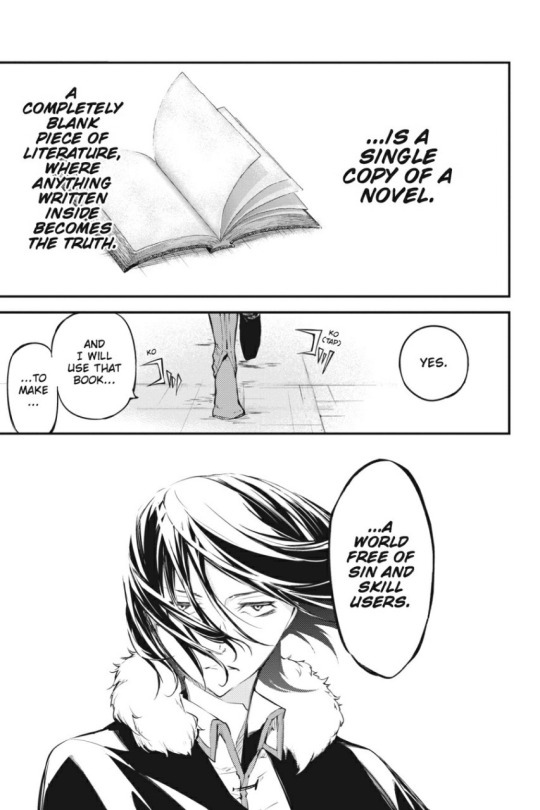
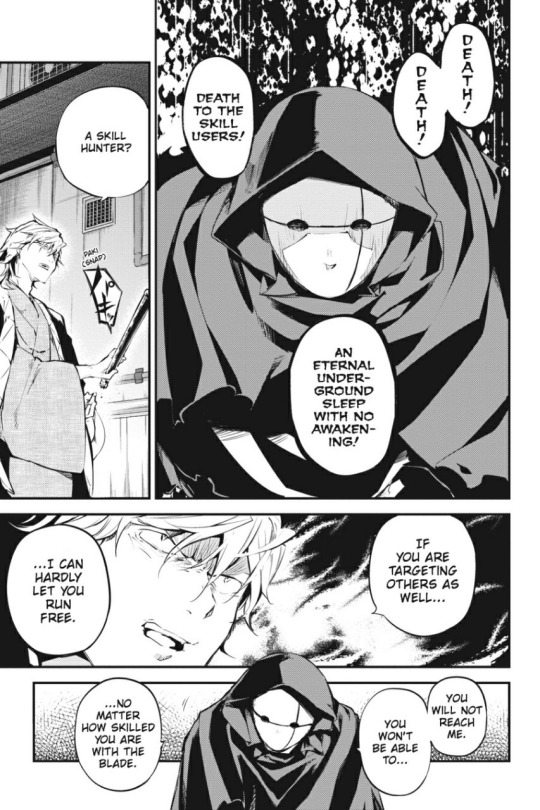
special thanks to @ticklinglady for finding these pages!
"... a world free of sin and skill users."
1. A world free of sin
He says he wants to spill the blood of the sinners like 3 times but doesn't really give an explanation of who, what or why.
His definition of "sin" is quite vague, but could be the usual christian/catholic/orthodox/etc (sorry it's been a while) stuff. The one time he identified a specific behaviour as a sin was when the Agency and Port Mafia were killing each other "even though they knew they were being set up to do so" (though he also said Ace breathing and thinking was a crime and said killing Karma was freeing him).
In the Dead Apple novelization (not written, but edited by Asagiri, who came up with the original idea for the movie and gave a whole speech on Fyodor to the writing team), Fyodor does make a speech about the post-dragon red fog surrounding the Earth, transforming it into a "dead apple" by essentially killing everyone and "washing away the original sin of man". The apple motif was a sort of poetic irony.

According to the novelization, this was his true objective at the time and he never mentions the Book, not even in the epilogue, as opposed to doing so in the movie.
This scenario is kind of a contradiction, since the fog would have erased everyone except ability users, though most would have suffered at the hands of their abilities before dying. Said abilities would have then been kept in a collection maintained by Shibusawa, an ability singularity himself, which brings us to...
2. A world free of ability users
I went through the manga and never did find an instance of Fyodor speaking ill of abilities, only ability users. That doesn't mean there is a difference to him in the first place, but it's interesting.
The Dead Apple scenario is to be taken with a grain of salt, but killing everyone doesn't seem to be a problem for him (he kills nearly everyone he interacts with anyway), and this implies that to him every single human is sinful beyond redemption and can only be saved through death. Why he is singling out ability users in that case? seems redundant.
Other instances of him talking about his objective included talking about "the will of the hand of God and Demon", doing this "for the sake of a better world", and saying the death he gives is a form of salvation by severing the influence of sins from the soul. He also talks a big game about God and his intentions (order and stuff), and Dazai likes to point and laugh at him when he does so.
As a bonus, in Dead Apple, Fyodor answered Dazai's question of why he accepted to join forces with him by saying it was "simply to see the world as it ought to be" (and because he wanted entertainment, with Dazai turning out to be that entertainment, as Fyodor was in fact using him the whole time for his own agenda).

now go and apply that knowledge to your theories
#and this is an open mic post if you have more feel free to add#i went through the entire manga and fyodor's scenes in the movie and his scenes in the novelization AND the DA prologue in mayoi#i don't know where else to look without getting ahead of myself#bsd#bungou stray dogs#bsd analysis#bsd meta#bsd manga spoilers#?#this was mostly because of the ''what are you'' in the last chapter#bsd fyodor#bsd fyodor dostoevsky#apparently i talk sometimes#i don't want to cut it it's not THAT long so#long post
140 notes
·
View notes
Text
I know some people say that at the end of DA2, Justice becomes Vengeance and while that’s not true given vengeance demons aren’t a thing, I think spirits of Justice would rarely become vengeance demons.
Spirits don’t have particular demons they always become. In Inquisition, Solas says spirits are purpose, and demons are purpose perverted. I think the demon a spirit becomes is dependent on the situation that causes them to become demons. A spirit of Love can easily become Desire or Hunger or Rage (hell hath no fury like a woman scorned, anybody?), for example.
In DA2, Anders says he feels he somehow corrupted Justice because Anders was too angry… but that doesn’t make sense? A key aspect of Justice (as a concept) in general is anger- Justice exists with a righteous fury. I think rage is too naturally a part of the concept of justice for spirits of justice to become demons of rage.
My theory: spirits of justice become either pride demons or despair demons. Pride demons are the most obvious, imo. A large part of the philosophical discussion of justice is who has the right to enact it. If someone is in a position of power, they can feel they have a right to enact justice on whoever they deem unjust regardless of mercy or compassion. With that, a danger of justice is dogma. There is no room for deeper understanding or compassion with dogmatic beliefs because dogma is always incontrovertible. Even questioning it instead of accepting it blindly with the upmost faith challenges it. Think of how Meredith perceives her position and actions.
Now, that is justice when given to people who already have authority- what does justice look like to those who are oppressed? Anders is a good case study as to why spirits of justice would often default to despair imho. Circles are obviously unjust and Anders dedicates his life to fighting it. But even with Anders constantly helping with the Mage Underground and writing manifestos, what can Anders actually do? Circles have existed in Thedas for millennia, and they are controlled by the Chantry. The Chantry has been propagating anti mage sentiment that entire time- even the Blight is blamed on the mages (mages became the darkspawn when they corrupted the throne of the Maker with their hubris, turning it into the Black City). The closest thing Andrastian has to the devil are mages. Anders can’t kill a few templars and save his people. The oppression of mages is an institution in Thedasian (idk if that’s the right word) society. This is widespread injustice- what can one single man do to dismantle an entire system of oppression? Even with all his work in the Mage Underground, he is still only able to help individual mages. This isn’t liberation- true justice- for his people. And he’s in Kirkwall of all places. Even by Circle standards, Kirkwall is notoriously bad. I don’t think Justice becomes Despair (I don’t think spirits bonded with people can become demons at all), but it is this chronic powerlessness, the entire notion of “no matter how much I do, it will never be enough”, that leads Anders to the chantry explosion. It wasn’t done out of rage or vengeance- it’s a logical conclusion made from desperation after years of trying everything else. The real question is whether or not such a drastic measure is worth it in the end.
Also this is why contrasting him with Fenris as foils isn’t exactly accurate. Fenris is against Danarius while Anders is against an entire system. Fenris can kill one man and be free, while mages are at risk most everywhere they go for their entire lives. Whether or not DA writers knew it, this is likely a fundamental reason Anders is frustrated with Fenris. It’s not until Fenris goes back to Tevinter as the Blue Wraith that I think we can actually compare them.
#sorry if this is all over the place I’m just rambling on my phone rn#Anders was right#Anders#dragon age#da2#da analysis#my post#fade talk#Fenris#Fenris and Anders
82 notes
·
View notes
Text
We as a society do not talk enough about Lisa Cuddy and her relationship with her mother. I love you both but I like her more. The fact that Cuddy doesn’t have a standard family. That she is passionate about her work but still cares for her daughter by herself. That just she has different priorities than her mother - and because of that, even being wildly successful and a great parent, still is criticized. And it’s not that much about high expectations as it is about different ones. That her sister fullfills them better just by having picked a different path in life, and that she’s the one to defend Arlene. It’s about not even being that deviant from the norm and still doing it wrong. And still, when push comes to shove, her mother cares about Cuddy - to the point of trying to bring her and House back together - but can’t bring herself to show it. God damn it.
#i feel like my analysis post are always messy and bungled#sorry got reminded of how good Family Practice was#house md#in da house#lisa cuddy#julia cuddy#arlene cuddy#meta
103 notes
·
View notes
Text
Rating/roasting Death costumes from Elisabeth das musical
So, this, ladies and gentlemen, is somewhat of my small magnum opus. I'm rating the costumes based on how well I think they're constructed, how much I think the design fits Death as a character and personal preference. What entitles me to undertake this task is me being a student of costume design at uni and being a crazy fan of this show
Disclaimer: I'm only rating costumes from the European productions of Elisabeth das musical, because this post would be way too long if I were to get into all the Japanese and Korean productions costumes.
Original (Vienna, 1992-1996)
Love the iridecsence and shimmer the fabric has, love how flowy it is, altough I wish I could see more contrast between the separate fabrics. The right amount of androgyny with the jacket skirt and the super fluffy hair to set the bar really high for future productions. But, it could have been tailored a bit more in some parts and the execution could have been a teensy bit better. A believable unearthly being. 9/10

German productions (2001-2008)
Not totally on board with making the entire costume black, since it can look a tad too plain in pictures, but that shimmery velvet is so pretty. Not sure if I like all of the seams finished by bias tape, leaning more towards no, since it's giving the costume more of a pyjama appearance rather than some luxurious fantastical coat. I love the cut they gave the jacket, because long jackets with trains are awesome, but with the amount of stories of Deaths tripping on it, I don't think a train is a wise choice for this role. The idea was there, but it wasn't thought through too well. 7/10

Budapest production (1996-2005, 2007-)
I love how goddamn shimmery this Death is! Like, it's balancing the line between being too much and just enough, but I love all the glitter going on. This Death looks like some otherworldly alien and for the most part, I am digging it. I love the decoration going on on the top part of the jacket, but I'm not sure if I like how baggy the coat's silhouette is. And I think the trousers could have benefited from some decorations, because they look like they belong to some other costume. Also, some Deaths wear a waistcoat with this costume and for that piece, I feel like the waistcoats are a bit too long. 8/10
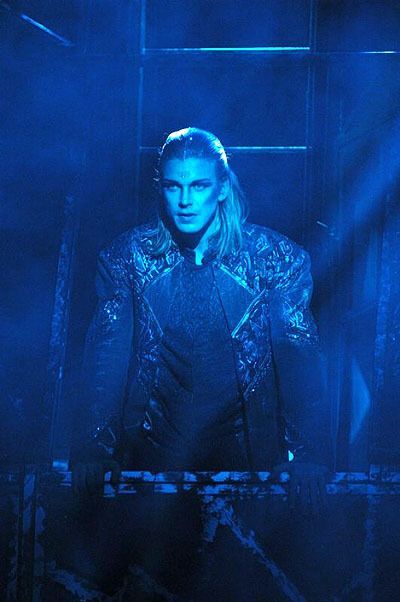
1st revival (Vienna, 2003-2005)
Kept the basic essence of the original design, but upgraded it with a cleaner execution and super sharp tailoring. It could have used some decoration, but I am not too upset about that. We lost a fair bit of the androgyny, but I like their decision to go for an empire style cut for the jacket. And the color contrasts between the black and that bright saturated ultramarine are so good. This design is simple, but hits hard and it's iconic for a good reason. 9/10

Finnish production (Turku, 2005-2006)
This feels very similar to the German tour design to me with the long coat, but with more decorations. I like the choice of the braided cording (perhaps as a nod to Elisabeth's love of Hungary by including elements similar to a hussar uniform). And I like the poofy shirt he seems to have underneath along with the fingerless gloves. But I'm not sure if gold was exactly the best color to use for the deco for Death (I think silver would have looked much better). So, poins off for that and for the trip hazard of the coat. 7.5/10

Flemish production (Antwerp, 2009)
An omen of the bland designs to come. Completely destroyed the color storytelling and made Der Tod look plain as heck. At least the tailoring seems decently good. The only saving factor other than that was the glitter on the black costume. 3/10

2nd revival (Vienna, 2012-)
No. Just... no. This is literally the most plain, most boring costume they could have given him. I get that they wanted to go for a more "masculine" look for Der Tod, but even if I was a fan of this approach, the execution is so boring. Like, the tailoring is good, but it's just bland overall as a costume (and you know you've got a bland costume at hand when the most interesting detail on it are two patches of quilted/couched pleather). It's missing everything that makes a Der Tod costume good in my book. This Tod isn't an otherworldly being, he's just... a dude in pleather. If I were Elisabeth, I would in no way be enchanted with this man and his untucked shirt. 2/10

Kecskemet production (Kecskemet, 2021-2022)
A bit unusual, I'm unsure if I like or dislike it. Like, he is very nicely dressed, which I like, the tailoring looks good, but he kinda looks like a pimp (I do like the cane, tho). With skunk hair, which I don't know if I'm a fan of. Also, I'm not really fond Death being in white through the whole show. And those white contact lenses this Death wears are kinda scary. 5/10
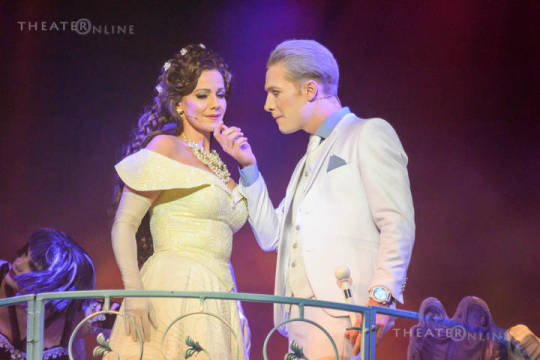
Czech production (Plzeň, 2019-2023)
I didn't think I'd like this costume this much, but this is like what the 2nd revival designers wanted to do with Der Tod, but were too afraid to do. In my opinion, this is how you do a Death costume out of pleather. Despite the material, the coat is flowy and has just the right amount of length to not be a hazard. All the little details you notice once you take a good look at this costume, despite it looking very simple at first glance, are so great! This is a Death, who doesn't quite understand the concept of how a human dresses and all those little details hint at that. I like the choice of making this Death styled after a crow/raven, down to that epic feather shoulderpiece. And thumbs up for them not being afraid to really go in with the makeup. 8/10

Bruxellons production (Brussels, 2022)
This Death costume is so simple, but I commend the designer for going for something new and fresh. The tailoring is crisp, I love the shade of blue they gave Death and the choice of a mesh shirt isn't something I would think I'd like, but I do like it. And I like that this Death has some accessories to complement the simplicity of the base costume. And I love the matching painted nails! It's very much something outside of the box of how we usually see Death designed and it's refreshing. 8/10
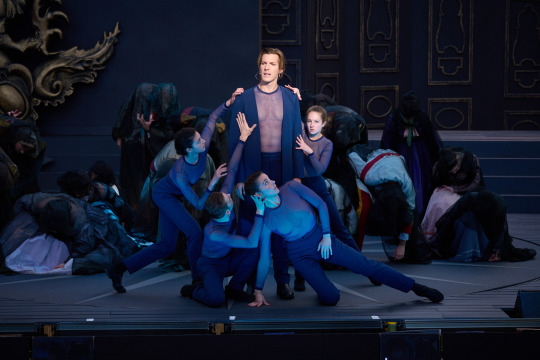
#elisabeth das musical#costume analysis#costume rating#der tod#this post was a month in the making#if you want to tag along reblog with your ratings
163 notes
·
View notes
Text
7 Common Tod & Rudolf relationship interpretations and what I think of them
1. "Tod was only using Rudolf to make Elisabeth depressed"
0/10 take. Not only does it simplify their relationship in a way that I feel does a disservice to the complex themes of the show, it also points to a worldbuilding view in which Tod is the cause (not a symptom or manifestation) of mental illness. Which I feel would trivialise the historical character's struggles and mental health issues in general.
2. "Tod is the manifestation of Rudolf's (and Elisabeth's) suicidal ideation."
7/10 take. I like it but it isn't as spicy as some others - just points to Rudolf having a very vivid and particular imagination. Lends itself to a lot of "that's kinda gay<333" takes which is A++.
3. "Tod is a supernatural figure that does what he does because he wants to consume Rudolf's life/soul, kinda like a vampire, or because taking people when their time comes is his duty."
8/10 take. The "sexy grim reaper" take. Can be combined with other takes that I enjoy.
4. "Tod is Rudolf's friend and confidante first and foremost and genuinely shares his wish for a better world. He doesn't want him to die, he wants him to live and succeed - and it's a terrible tragedy that even with all his power, he can't control the fate and time of death of humans that he cares about."
10/10 take. The Bruxellons take. Makes me feel so many tender and painful emotions.
5. "He literally just wants to f -"
11/10 take. The Máté Kamarás & Oliver Arno take. Fjödjfösld I'm only half joking.
6. "Tod does exist, does care for Rudolf, and wants to keep him/tempt him to join him in death/the afterlife/whatever."
6/10 take. A pretty uncommon take, tends to be more common for Tod and Elisabeth. I like it in fanfic, but I really hate it for Tod and Elisabeth, and sometimes it exists for both Elisabeth and Rudolf at the same time in fics XD And you do have to kind of explain away why Rudolf stayed and Elisabeth didn't, if you choose that route. This one also isn't really supported by canon in most productions.
7. "Tod doesn't exist and the Rudolf we see in the musical is not a self-directed agent but a fabrication of Lucheni's. This is why he's portrayed sympathetically (the irl Lucheni received a letter from a fellow anarchist that called Rudolf "a friend of the people" and said that Elisabeth's murder was justified because it was her and FJ who caused Rudolf's death). The reason Tod and Rudolf interact as they do in Schatten is because Lucheni is projecting his own... uh, goals and desires (he seeks death and wants to change the world) onto their relationship and onto Rudolf as a character."
900/10 take. Serkan Kaya's Lucheni is my favourite fanfic author ❤️
the last one isn't really common, it's just a take i've been rotating in my head recently
#musicals#theatre#analysis#kronprinz rudolf#der tod#jalsls do i dare to tag the show#maybe i do#elisabeth das musical#just my opinions!
153 notes
·
View notes
Text
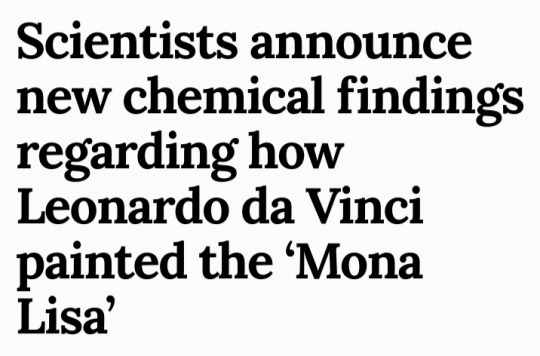



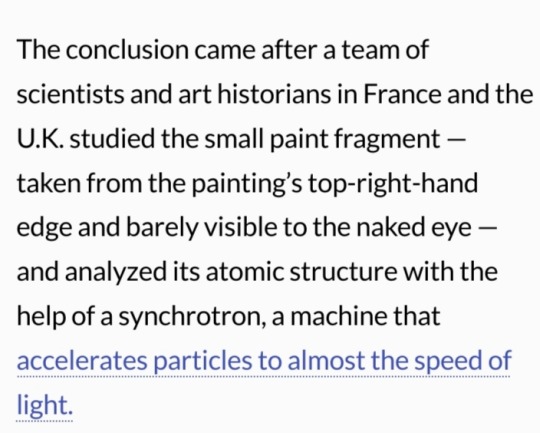
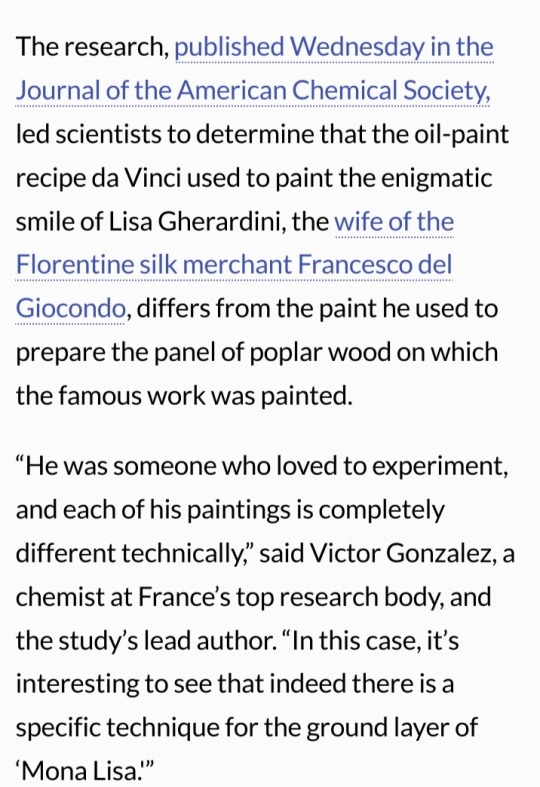


#Mona Lisa#Leonardo da Vinci#Louvre Museum#plumbonacrite#synchrotron#Journal of the American Chemical Society#Lisa Gherardini#Francesco del Giocondo#paint fragment#painting#lead oxide#chemical analysis
13 notes
·
View notes
Text
you know those old avengers fanfics that were just all the avengers hanging out in that tower or whatever. someone should write a fic like that except its all the different Tods
#i was never into the mcu in case you couldnt tell#anyway ive been thinking about the characterisation differences between the tods in different productions but i cant produce any#coherent analysis so you get this instead#i think uwe!tod and asaji!tod would hang out i think they would really enjoy doing diffrent activities in the same room#elisabeth das musical
12 notes
·
View notes
Text
Two Sides of a Coin with No Edge - Anders and Fenris Parallels
A little analysis that isn't really that well organised right now but I have plenty of thoughts around how these two are opposite and yet so similar...
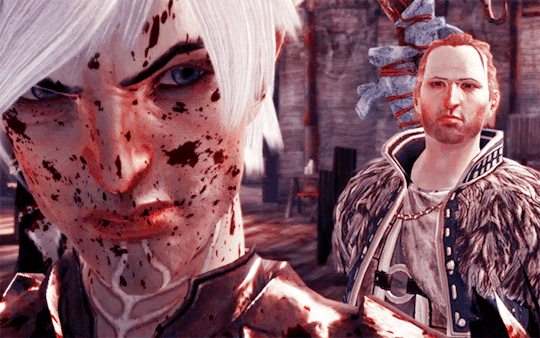
More beneath the cut~
Names - Anders never had a name, or he likely doesn’t remember it. What he uses is what was given to him. It has little to no meaning. Fenris gave up his name, and had it replaced with one with meaning. The meaning being almost derogatory, another form of ownership over his identity, but it’s one that eventually he could drop and take his original back when he meets Varania. He could...but no. He's not Leto any more, and can't be. That's lost. As lost as Anders' original name and who he might have been before the magic manifested.
Family - Anders has no way to ever know or track down his family. They're gone, all knowledge of them severed from him. (Unless this is covered in a book or comic I haven't got to yet). Fenris actually has a chance to reunite with his sister Varania, to know more about their mother too, but...he also can't. She's a mage, a symbol of everything he has learned to hate and fear from years of pain. How could he resume that connection?
Safety - Anders is being hunted. He’s always going to be hunted. The phylactery can track him, and if not he can likely be traced by what he’s done, where he goes. Even when the Wardens mean he can stop being pursued as an apostate, leaving them means getting chased down for that instead. Fenris is also being hunted. He has been for a long time…but once Danarius is gone, he’s free. He has an out.
Persecution - As a mage, Anders has always had that prejudice towards him. But in other ways he could blend in if he wanted to. He’s human, he could choose not to use magic once he has control over it and wear less obvious robes. He could potentially hide properly. Not that he would given who he is, but the option is there. Fenris will always be an elf, and his tattoos can’t be hidden. They’re going to mark him apart even from other elves. He was born in a place where not only was he going to be a second class citizen from day 1 as elves are across most of Thedas, but most of his people are enslaved too.
Control - Both of them have little control over the powers that are bound to them, even though both chose it. Fenris might not remember, but it is clear he made a decision to have the lyrium bound to him. Just like Anders chose to bring Justice into himself. They both show that emotions can bring out those abilities or that side of them. Fenris glows with his rage just as much as Justice comes to the fore when Anders is in a strong emotional state or faced with certain situations.
Emotions - They are also both highly emotional people. Anders shows more of the swings back and forth, with all kinds of emotions felt more strongly than most people - whether that is how quickly and deeply he falls in love, or how furious he becomes with injustice. His emotions are at the fore, strong, powerful, because that’s how he is, who he is. Fenris on the other hand struggles more purely with anger, frustration, and a very violent reaction to certain situations and people. He doesn’t allow himself to feel close to people easily because that might be a weakness someone can use against him. It takes him a lot to hold back from hurting Varania when he hears about his past, and he’s clearly still struggling with anger even after Danarius is gone.
Forgiveness - Both of them have a strong sense of justice, just aimed in different directions. Anders has felt the oppression of being a mage and everything that goes with that for most of his life. Fenris has felt the same but the source of that has been mages. Anders can’t forgive the Templars any more than Fenris can let go of his fear/hate of magic. They both know and eventually accept there can be good people on the other side, but it takes them a long time to get to that point. And neither can forgive the society that enabled their persecution.
They have so much in common but they can never see it, never truly reconcile. Anders sees someone who is determined to oppress his people, who only believes them to be dangerous and violent, who thinks the only way to prevent harm is to lock them all up and control them even if they’re innocent. Fenris sees someone who wants to unleash danger on the world, to let criminals and enslavers run wild and free to use people like him for their own power, who wants to set every mage free without supervision, inviting abominations to destroy everything good and precious in the world.
By design they can never see eye to eye, even the most determined therapist would concede they both have too much pain to reconcile as acquaintances.
Two sides of the same coin with no way to balance on the edge.
---
That's about all the thoughts I have in me for now~
16 notes
·
View notes